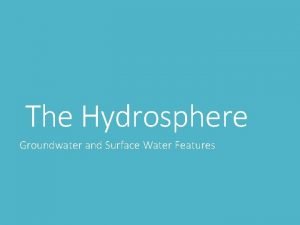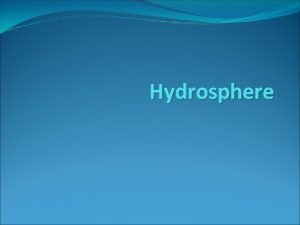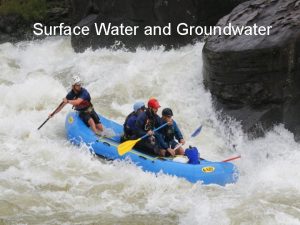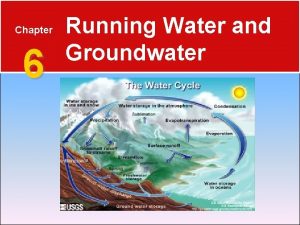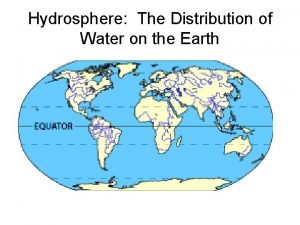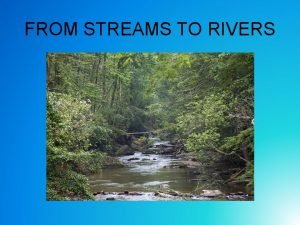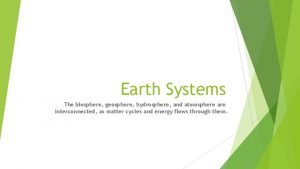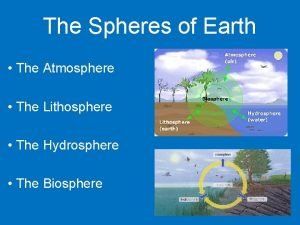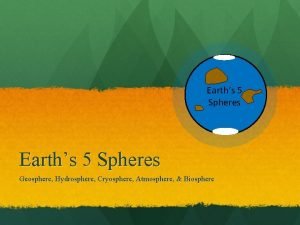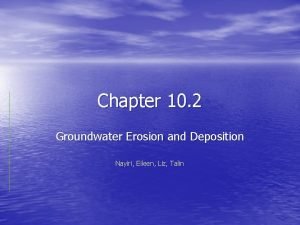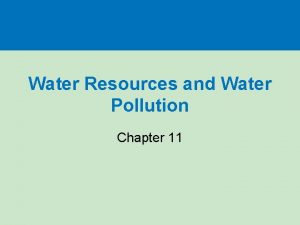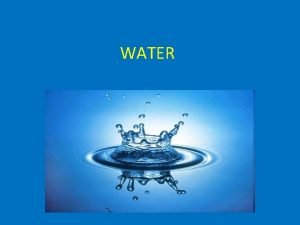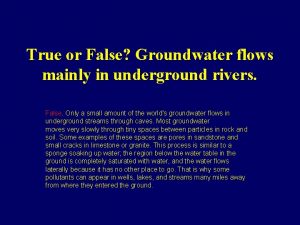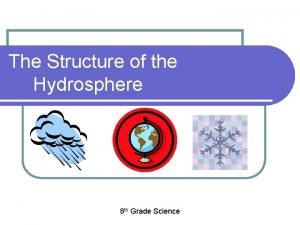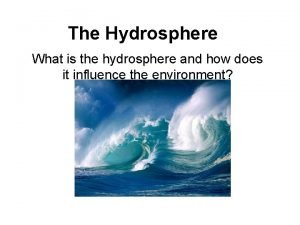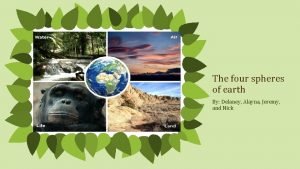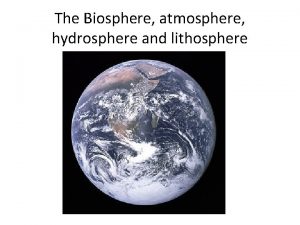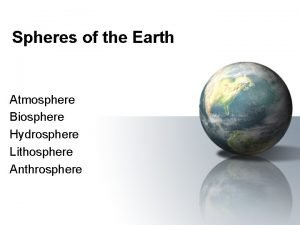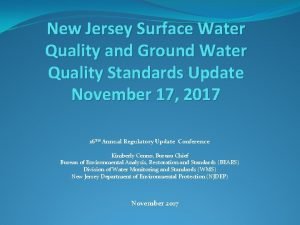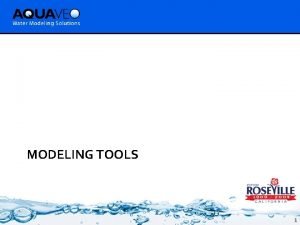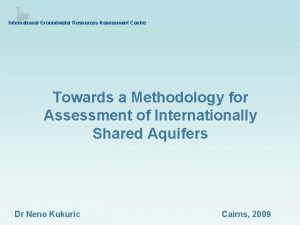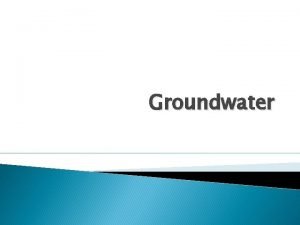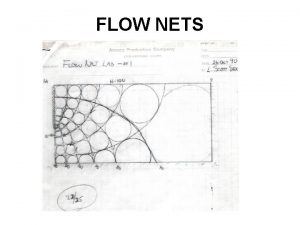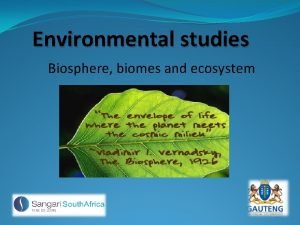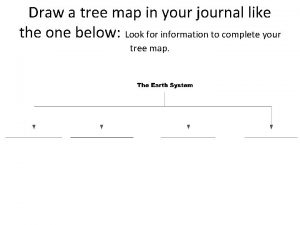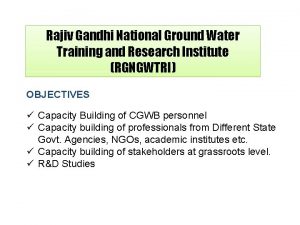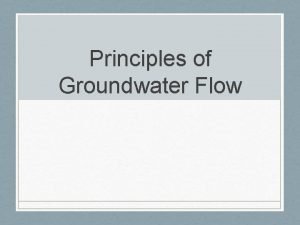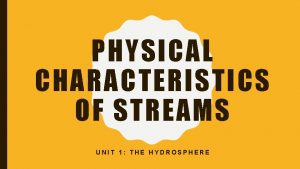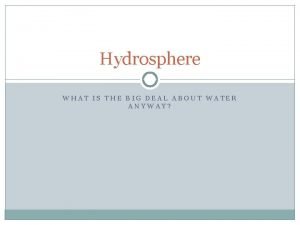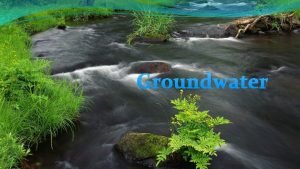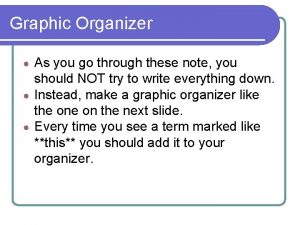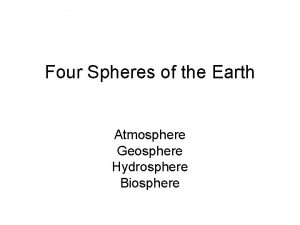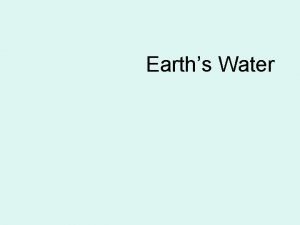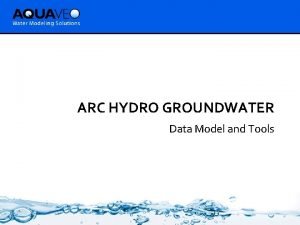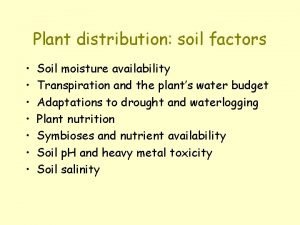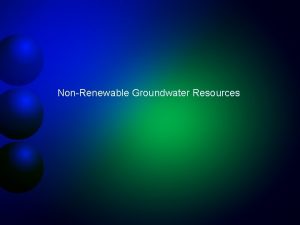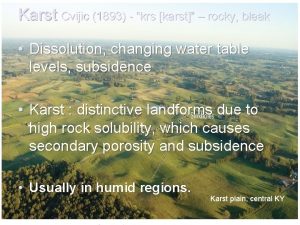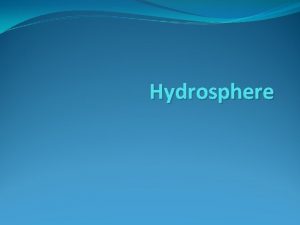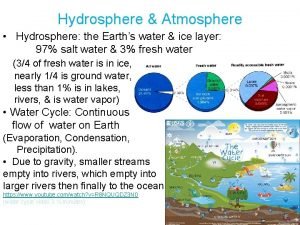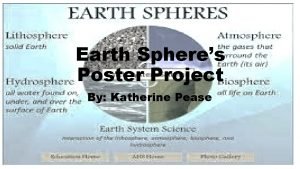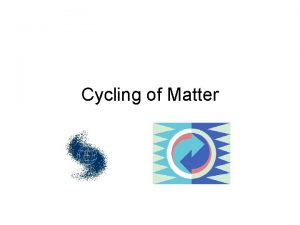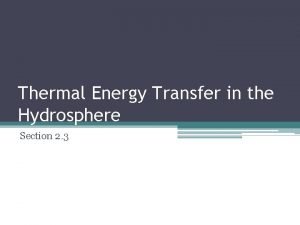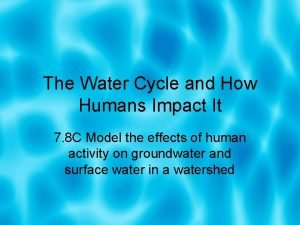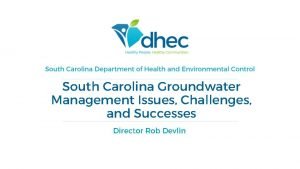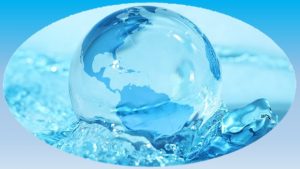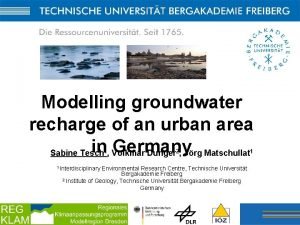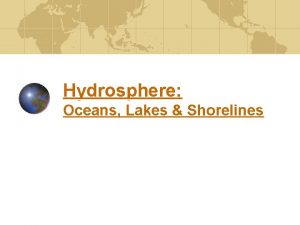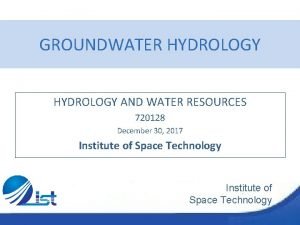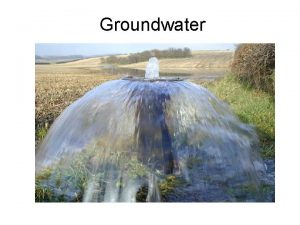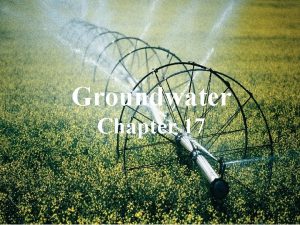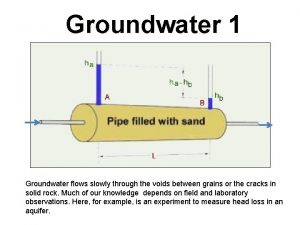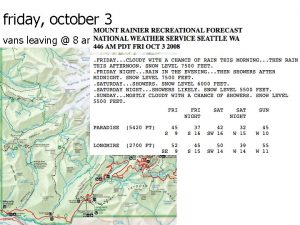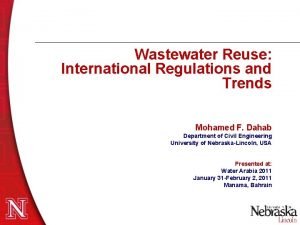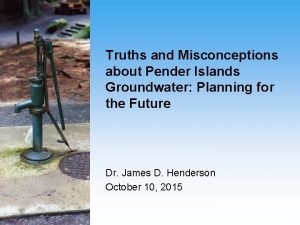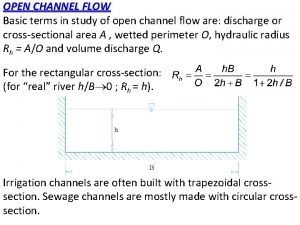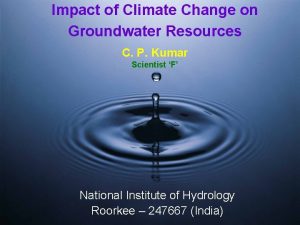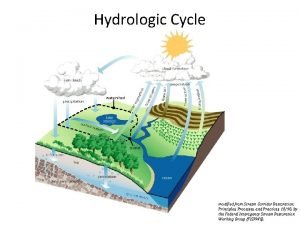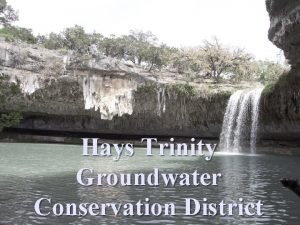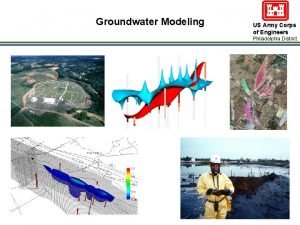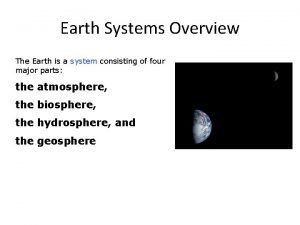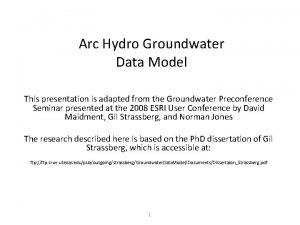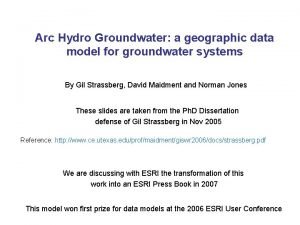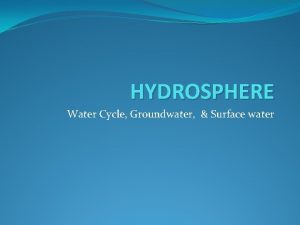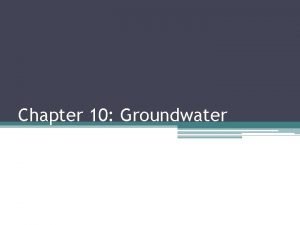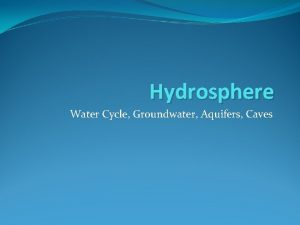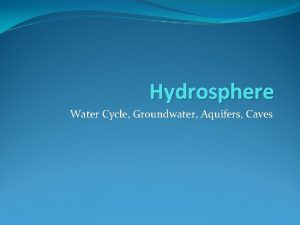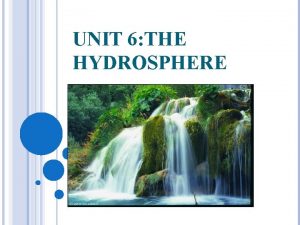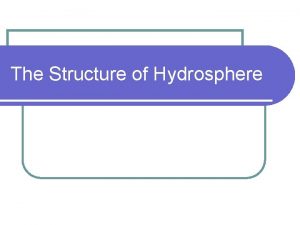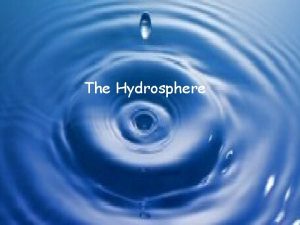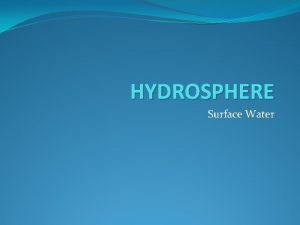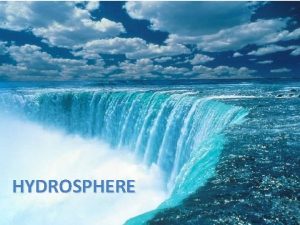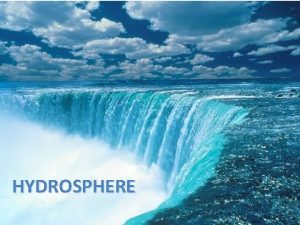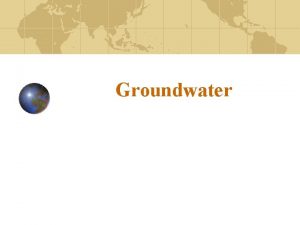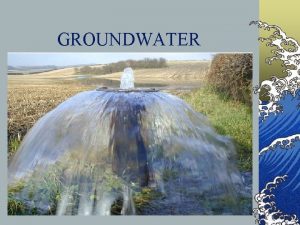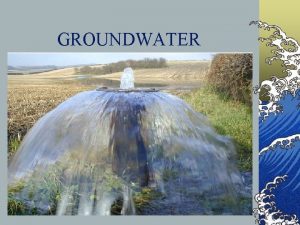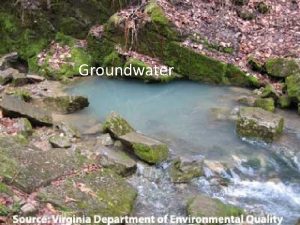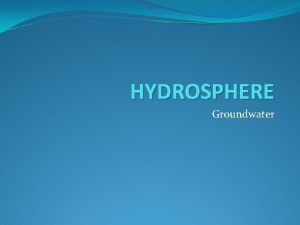The Hydrosphere Groundwater and Surface Water Features Water









































































- Slides: 73

The Hydrosphere Groundwater and Surface Water Features

Water Properties Water is a necessity, a resource, and a factor in pollution because of it’s unique properties: o High capacity to absorb and store heat o Universal solvent o High surface tension o Less dense as a solid o Penetrated by sunlight

Global Perspective Problem: Growing global water shortage linked to our food supply 97% of the hydrosphere is in the oceans and 2% trapped in glaciers or ice sheets 0. 001% of the hydrosphere is in the atmosphere at any given time and that small amount drives weather systems that deliver freshwater through precipitation

Global Perspective We currently use more than half of the world’s reliable runoff of surface water and could be using 70 -90% by 2025. About 70% of the water we withdraw from rivers, lakes, and aquifers is not returned to these sources. Irrigation is the biggest user of water (70%), followed by industries (20%) and cities and residences (10%).

Is it safe to drink? Mostly safe in the U. S. and developed countries Some discomfort may result if someone is not used to local water bacteria Fresh potable water is a major issue in developing countries - even in cities India Nigeria Sudan, etc.

The Hydrosphere Water cycle: the constant movement of water through a system that recycles the Earth’s supply of fresh water, powered by the sun Should be a balance between precipitation and evaporation to have a balanced water budget

Water Supply and Use Amount of water vapor passing over the US every day equals ~ 152, 000 million m 3 10% falls as precipitation (66% of which is evaporated or transpired) Only 34% enters surface or groundwater

Water Supply and Use In developing water budgets for water resources management it is useful to consider annual precipitation and runoff patterns. Potential problems can be predicted in areas where average runoff and precipitation low Total storage of runoff not possible because of evaporative losses Because there are large annual and regional variations in stream flow, even areas with high precipitation and runoff may suffer from droughts.

The Hydrosphere Water that falls on the surface is carried across the surface of the earth and settles in areas of lower elevation due to gravity and runoff Factors that affect run-off: Vegetation (decreases water on the surface) Rate of Precipitation (heavy rainfall increases water on the surface) Slope (steep slopes increase water on the surface) Soil composition (soil with larger spaces between sediments decrease water on the surface)

Water Supply and Use ½ the people in the US use groundwater as a primary source of drinking water Accounts for 20% of water used In many parts of the country withdrawal from wells exceeds natural inflow Overdraft Changes to river basins Land subsidence

Groundwater • Water that seeps underground from the surface during the step in the water cycle called infiltration becomes a part of the groundwater. Groundwater: water found underground in the zone of saturation

Groundwater Zone of Aeration: area of unsaturated soil above the water table Water table: the highest point of saturation from groundwater in a soil profile Zone of Saturation: area where water fills all of the open spaces in sediment and rock

Groundwater What causes water move underground? Porosity: the amount of space in between sediments More space = higher chances of water moving through the sediments or being contained by the sediments

Groundwater Porosity determines whether a soil is permeable or impermeable. Permeable: allows water to flow through Impermeable: does not allow water to flow through it

Groundwater Permeability of soil and rock layers determines where water will be contained within the layers of sediments. Aquifer: layer of soil or rock underground that is able to store water or allow water to pass through it Aquiclude: layer of soil or rock underground that prevents water from getting through

Aquifers around the World Ogallala Aquifer -Located in the central US Great Artesian basin -Largest in the world, Australia Guarani Aquifer -Located under Argentina, Brazil Paraguay and Uruguay

Groundwater Erosion and Deposition Most groundwater contains small amounts of carbonic acid, a combination of water and carbon dioxide, that is able to chemically weather softer rocks like limestone Slow, steady weathering of rocks through this process can dissolve away large amounts of rock underground leaving behind open spaces called caves

Cave formation and landscape Karst Topography is the name for a region of land that contains large amounts of soluble rocks that dissolve to create landforms like caves and increase chances for sinkholes Animation of Cave Formation

Cave formation and landscape Continued chemical weathering through carbonation creates small amounts of calcite in the water that collects and deposits in cave systems creating features like stalagmites and stalactites Stalactite Stalagmite

Cave formation and landscape

Where groundwater meets surface water… Spring: where groundwater intersects with the surface Usually caused by a rise in the water table or erosion that exposes the aquifer underground.

Where groundwater meets surface water… Types of Springs Hot spring: springs that are warmer than the annual temperature of the air in an area Geyser: hot spring that shoots water into the air because of the build up of steam

Where groundwater meets surface water… Well: a hole bored into the zone of saturation to access groundwater Artesian well: water naturally rises to the surface Pumped well: requires pressure and energy to get water to the surface

Quality of Groundwater When water is drawn from the groundwater supply using a well, overuse of the well can result in a negative effect on the water quality and supply Cone of Depression: sinking of the water table around a well

Groundwater Concerns 1. Chemicals and Pollutants Surface spills, sewage leaks and landfill contamination are just a few threats that could damage clean water supply 2. Overuse Groundwater supplies can be depleted if more water is drawn from a supply than is replenished by infiltration 3. Subsidence Sinking of the land due to underground water loss

Groundwater Concerns Hard Water Soft Water • Contains significant amounts of dissolved minerals like calcium and magnesium • Leaves spotty residue when used for cleaning and does not lather well with soap • Increased mineral content means increased health benefits • Treated to remove minerals, only contains sodium ions • Often tastes salty • Leaves behind no spotty residue when cleaning

Surface Water * Freshwater on the surface only makes up about 0. 03% of the 2. 8% of the total freshwater supply.

Surface Water on the surface comes from precipitation and run off that does not seep into the groundwater supplies but instead becomes part of a natural watershed. Watershed: land from which water runs off into streams (drainage basin) Divide: ridges or elevated regions of high ground that separate watersheds

Surface Water North Carolina Watersheds

North Carolina Watersheds North Carolina has 17 river basins o 12 flow into the Atlantic Ocean o 5 empty into the Mississippi river that then flows into the Gulf of Mexico o 11 of the river basins begin in North Carolina but only 4 end there too o The Cape Fear river basin is the largest in North Carolina and the only one that flows directly into the Atlantic Ocean making it useful for the shipment of materials (Ex: Wilmington Port)

North Carolina River Basins The Neuse River basin is the longest river contained within North Carolina’s borders, flowing through 11 counties At it’s mouth it is the widest river in America (6 miles across) Begins at Falls Lake Reservoir dam Flows to New Bern, where it mixes with seawater and becomes a tidal estuary At New Bern, it empties into the Pamlico Sound

Major U. S. River Systems Mississippi River Basin

Surface Water North Carolina Rivers

Surface Water on Earth is balanced by precipitation and evaporation Streams move water on the surface to regulate fresh water and carry sediments from small waterways to larger bodies of water

Surface Water Freshwater on the surface often occurs in the form of streams that carry water from a source to a larger body of water Effluent Stream A type of stream where flow is maintained during the dry season by groundwater seepage into the channel Influent Stream A type of stream that is everywhere above the groundwater table and flows in direct response to precipitation

Surface Water

Surface Water Both locations of freshwater should be considered part of the same resource. Nearly all surface water environments have connections to ground water Example: withdrawal of groundwater can lower stream flow or lake levels Pollution can spread from one source to the other

Surface Water Use Off-stream use: water removed from it’s source for use e. g. irrigation, drinking, washing In-stream use: The use of water without removing it from its source Example: the use of rivers for navigation, hydroelectric power generation, fish and wildlife habitats and recreation

Surface Water Use Problems with off-stream use include determining how much water can be removed without damaging a stream ecosystem. Example: On the Aral sea locals diverting water for agriculture have caused the sea to dry up Surface area of sea reduced 90% in 50 years

Surface Water Properties of Streams The following properties are things that affect the characteristics of a river and how it changes the landscape that it is in. Velocity: how fast the currents in a stream move water and sediments.

Surface Water Properties of Streams Gradient: the slope or steepness of a stream Discharge: the volume of water flowing in a stream at a certain point

Surface Water Properties of Streams • Streams flow from higher elevations to lower elevations and end up in a larger body of water like a lake or ocean • In the process, streams carve out a pathway called a stream channel that changes the landscape of a region Stream Channel: the path that water in a stream follows, changing with erosion

Surface Water Stream Erosion * Moving water weathers down rocks in a stream channel and erodes the land by moving sediments downstream BANK BED Erosion stops when a stream hits the base level. Base level: the lowest point that can be eroded

Surface Water Stream Erosion • Streams transport sediments through erosion in 3 ways: Bed load: along the bottom of the stream channel Suspended load: suspended in the water column Dissolved load: dissolved minerals in the water

Surface Water Stream Erosion stream load: material carried by a stream capacity: the amount of load or material a stream can carry (all 3 types added together)

Surface Water Stream Erosion • Where a stream or river begins (usually at a spring) is called a headwater • Headward erosion: is the process responsible for lengthening a stream or river Most headwaters are found in mountain regions where groundwater intersections are more likely.

Surface Water Stream Erosion * Most streams move outward from their headwaters toward lower elevations that lead to larger bodies of water. This changes the river characteristics through branching and turning.

Surface Water Stream Erosion Tributary: feeder stream that flows into a main river or larger stream Meander: bends or curves in a stream channel

Surface Water How meanders work Fast moving currents on the outside of the curve pick up sediments Slow moving current on the inside deposit sediments

Surface Water River Stages Youthful river: straight erodes rapidly V-shaped few tributaries has waterfalls and rapids

Surface Water River Stages: Mature River: meandering slow erosion U-shaped lots of tributaries holds lots of water

Surface Water River Stages: Old-age River: gradient and velocity decreases no more erosion more meandering

Surface Water River development typically follows the pattern of youthful rivers transitioning into old-age rivers as the slope decreases and erosion slows Rejuvenation occurs when an uplift along the course of the river increases the slope of an area and therefore increases erosion to make a river youthful again.

Rejuvenation

Surface Water Stream Deposition: the settling of sediments in the stream channel because of lower velocity currents in an area

Surface Water Stream Deposition Delta: accumulation of sediment formed where a stream enters a lake or ocean and sediments are sorted according to their size

Surface Water Sorted material forms a fan-like area of deposition at the mouth of a delta called an alluvial fan Large sediments Medium sediments Small sediments

Surface Water Stream Deposition Estuary: area where a freshwater river or stream enters the ocean Characteristics: -Mix of fresh and salt water (brackish) -Diverse habitats -Transition zone from the river to the sea

Surface Water The second largest estuary system in the United States is the Albemarle-Pamlico system in North Carolina.

Albemarle-Pamlico Estuary Freshwater enters the Albemarle and Pamlico sounds then deposits sediments to build up the estuary.

Surface Water Stream Deposition Along the boundaries of estuaries and river systems wetlands develop and create a buffer between the water systems and normal ground surfaces. Wetland: area covered or soaked in water for most of the year (also called marshes, swamps or bogs)

Surface Water Stream Deposition Levee: deposits of sediments on the sides of a river or stream during floods that run parallel to the stream flow These can also be manmade to contain higher stream discharge during a flood.

Surface Water Stream Overflow Flood: discharge of a stream or river that is too much for the stream channel to hold Floodplain: any area covered by water during a flood

Surface Water Flood Control Flood control dams: blocks in a streams natural flow that hold water back and then let it out slowly Limiting development: marking off certain areas of land that cannot be built on in a floodplain

Other Freshwater Features Lake – a depression in the surface materials of a landscape that collects and holds water. Lake Facts: v. Usually connected to streams, rivers, or empties into an ocean. v. Has a constant supply of water. v. Some are used as a reservoir to hold water

Freshwater Features Formation of Lakes Streams can be cut off (oxbow lake) Glacier remains (kettle lake) Dissolved limestone Man made

Freshwater Features Lake Changes Lakes can undergo changes from rain, runoff, and underground sources. Eutrophication The process by which lakes become rich in nutrients from the surrounding watershed, resulting in the change of the organisms in the lake

Water Trapped in Ice Glaciers make up the largest portion of freshwater found on Earth. Most of this is trapped in ice shelves at the North and South pole. Glacier: thick ice mass formed over a long period of time, also described as a slow moving river of ice

Water Trapped in Ice Types of Glaciers Continental Glaciers (Ice Sheets) Ice packs that cover extremely large areas Valley Glaciers Smaller ice packs that move through mountain valleys

Water Trapped in Ice Glacial Movement START: A build up of pressure from the weight of the ice and gravity initiate glacial movement CONTINUED: Gravity and low friction on the bottom of the glacier continue the downward movement

Water Trapped in Ice Anatomy of a Glacier Snowline: lowest point of snow accumulation Zone of Accumulation: where snowfall is increasing the mass of the glacier Zone of Wastage: where melting is decreasing the mass of the glacier

Water Trapped in Ice Glacial Erosion * Caused by abrasion and plucking as the ice moves across the land. This can pick up large sediments and carry them in the ice mass.

Water Trapped in Ice Glacial Erosion • Erosion leaves behind distinct landscapes that leave a historical record of where glaciers have been over time. Erratics Kettles Glacial Grooves
 Hydrosphere groundwater
Hydrosphere groundwater Short note on hydrosphere
Short note on hydrosphere Water and water and water water
Water and water and water water Running water and groundwater
Running water and groundwater Chapter 6 running water and groundwater
Chapter 6 running water and groundwater A tiny groove in soil made by flowing water
A tiny groove in soil made by flowing water Hydrosphere images
Hydrosphere images How does groundwater rejoin the water cycle
How does groundwater rejoin the water cycle Hydrosphere
Hydrosphere Geosphere atmosphere hydrosphere and biosphere
Geosphere atmosphere hydrosphere and biosphere Hydrosphere and cryosphere
Hydrosphere and cryosphere Earth's 5 spheres
Earth's 5 spheres Groundwater erosion and deposition
Groundwater erosion and deposition Surface area of a cone
Surface area of a cone Surface area formula of prism
Surface area formula of prism Source of contamination
Source of contamination How to decrease water pollution
How to decrease water pollution Ten uses of water
Ten uses of water True or false: groundwater can flow.
True or false: groundwater can flow. Structure of the hydrosphere
Structure of the hydrosphere What is the hydrosphere
What is the hydrosphere Geosphere defintion
Geosphere defintion Biosphere
Biosphere How does biosphere interact with hydrosphere
How does biosphere interact with hydrosphere Njdep surface water quality standards
Njdep surface water quality standards Gms groundwater
Gms groundwater Groundwater assessment methodology
Groundwater assessment methodology Hydrosphere study guide answers key
Hydrosphere study guide answers key Water table
Water table Septic tank contamination groundwater
Septic tank contamination groundwater Groundwater flow net
Groundwater flow net Hydrosphere layers
Hydrosphere layers Spheres of the earth concept map
Spheres of the earth concept map Brainpop carbon cycle
Brainpop carbon cycle Rgngwtri
Rgngwtri Hydrolic head
Hydrolic head Characteristics of hydrosphere
Characteristics of hydrosphere Whats hydrosphere
Whats hydrosphere Groundwater porosity
Groundwater porosity Ocean zones graphic organizer
Ocean zones graphic organizer Geosphere
Geosphere Stream load
Stream load Arc hydro groundwater
Arc hydro groundwater Groundwater table
Groundwater table Non resources
Non resources Poljes
Poljes The hydrosphere includes
The hydrosphere includes Hydrosphere layer
Hydrosphere layer 4 spheres poster
4 spheres poster Hydrosphere pictures
Hydrosphere pictures Hydrosphere
Hydrosphere Human impact on groundwater
Human impact on groundwater Groundwater
Groundwater Cut bank geography
Cut bank geography Groundwater system
Groundwater system Iöz
Iöz Hydrosphere
Hydrosphere بئر ارتوازي
بئر ارتوازي Uses of surface water
Uses of surface water Importance of groundwater
Importance of groundwater Groundwater
Groundwater Base level river
Base level river Groundwater recharge pdf
Groundwater recharge pdf Groundwater
Groundwater Groundwater flow definition
Groundwater flow definition Iot iran
Iot iran Groundwater mining
Groundwater mining Water balance equation
Water balance equation Hays trinity groundwater conservation district
Hays trinity groundwater conservation district Us army corps of engineers philadelphia district
Us army corps of engineers philadelphia district Groundwater information network
Groundwater information network Earth systems
Earth systems Arc hydro groundwater
Arc hydro groundwater Arc hydro groundwater
Arc hydro groundwater
